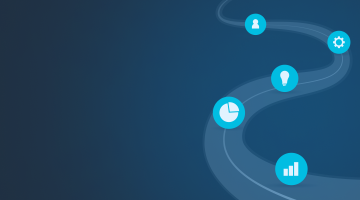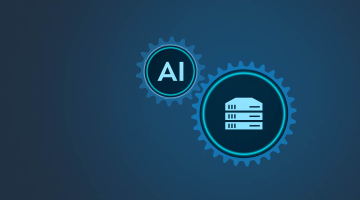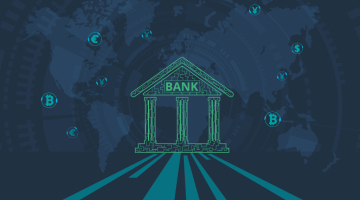

Customer analytics software for banking: A closer view
Banking has always been a highly competitive industry. It is hard to stand out among your rivals in the field because the scope of services any financial institution provides to corporate and individual clients is pretty much universal. This list (with minor variations) includes accepting deposits, advancing credits, issuing loans, debit and credit card operations, currency exchange, etc.
The advent of computer technologies and the onset of the global pandemic have created a growing demand for remote financial services, leading to the widespread introduction of digital banking instead of conventional brick-and-mortar storefronts. However, a modern fintech solution utilized by a bank isn’t a competitive differentiator anymore but a sine qua non for any financial institution keeping abreast of time.
What can give the bank an edge over its rivals, with everything else equal? To succeed in the domain, you must apply advanced customer analytics to understand the needs and divine the expectations of your target audience. In the early third millennium, when digitalization reigns supreme, such evaluative and prognosticating techniques come in data analytics software.
Explore our digital transformation services for banks
Connect with a professional team to address your project challenges.
Customer data analytics: A closer view
Today, the product-oriented policies practiced by many banks for decades prove outdated and require significant overhauling. Banks must switch to a client-centered approach to stay afloat and thrive in the contemporary competitive environment. This means making important business decisions and building strategies based on customers’ backgrounds, behaviors, and preferences.
To reach this overarching goal, financial organizations leverage customer profile software that gives them a 360-degree view of the client. This first stage of client analytics is typically known as business intelligence (BI), when you identify the target clientele and obtain all possible information from external and internal data sources (purchases, registrations, loyalty memberships, surveys, subscriptions, etc.) pertinent to potential or current customers.
Yet, possessing the data won’t help you much unless you can slice and dice it properly, deriving valuable insights. Here, customer analytics tools step in, segmenting customers and furnishing valuable foresight on what should be done to cater to their shifting needs. Let’s discover how customer analytics software helps banks in their shop floor operations.
Benefits of customer analytics in banking
As leading experts in fintech software development, we at DICEUS know the weighty advantages banks and financial institutions obtain by making analytical tools part and parcel of their digital infrastructure.
In-depth customer insights
Customer analytics solutions help banks get access to every piece of information concerning their clientele, including customer needs, preferences, tastes, and pain points. When supplemented by their demographics and transaction history, such customer data creates a comprehensive picture of consumers, allowing financial organizations to understand customer journeys, pinpoint factors triggering conversion, and model customer behavior by applying predictive analytics mechanisms.
Adopting informed decisions
The assembled big data is utilized to derive insights that are highly instrumental in further decisions aimed at identifying the most profitable revenue sources, optimizing marketing strategies, crafting the best-in-class banking products and services, establishing balanced interest rates, conducting sales forecasting, improving resource allocation, and more.
Exploiting cross-selling and upselling opportunities
As many entrepreneurs admit, cross-selling and upselling account for 30% of their revenues, so ignoring this source of income in the banking industry is a felony. By analyzing client profile data, financial companies, credit unions, and banks evaluate customers’ purchasing behavior to offer them upgrades or premium versions of their products, promote complementary services, and meet customer expectations halfway.
Fostering customer-centric culture
Maximum customer satisfaction is the name of the game in all business models, and the banking business is no exception. Advanced analytics techniques enable fintech companies to prioritize the needs and requirements of each client and offer them personalized services, which helps them tap new growth opportunities, minimize customer friction at all stages of their journey, improve customer loyalty, enhance brand reputation, facilitate customer acquisition, widen customer base, and curtail churn.
Reducing expenditure
By having the correct data from multiple sources at your fingertips and using it effectively, both traditional and other banks cropping up recently (neobanks, challenger banks, and more) can facilitate and streamline operations pertaining to their client-facing workflows. As a result, they cut down on manual labor, increase workforce efficiency, and augment productivity, ushering in significant cost savings.
Regulatory compliance and reporting
Numerous legal norms regulating operations in the banking domain impose stringent boundaries on financial organizations, violating which incurs hefty penalties and reputational damage. Customer analytics tools can help them group clients according to their risk profiles, thus simplifying anti-money laundering efforts and adherence to know-your-customer (KYC) requirements. Thanks to them, compliance officers can focus on monitoring high-risk clientele and produce audit reports much faster.
In what financial workflows do actionable insights furnished by customer analytics systems bring the most value?
Top challenges customer analytics software for banks addresses

Having considerable experience in the sphere, we at DICEUS know that, although it is honed primarily to enhance banks’ awareness of their clients, customer information software can be used to deal with a plethora of related issues as well.
Customer data handling
Customer data software is mainly for this purpose. By having a comprehensive picture of clients and their interactions with the bank, its experts can significantly streamline or even automate detecting symptomatic trends, accurately forecast customers’ future behavior, and map out the bank’s promotion campaigns or other business moves correspondingly.
Customer segmentation
You can provide better service aimed at those clusters once you segment your clientele into groups according to various principles (from behavior to income level). An essential criterion for this parcellation is customer lifetime value. This index estimates the expected profit the organization will receive during the entire time of cooperation with a particular client. Knowing it, you can shape your long-term strategy to maximize the profitability of lasting relations with every client within the group.
Personalization of services
Customer analytics solutions allow banks to zoom in on every client within the group determined by segmentation, unleashing personalized marketing techniques and algorithms, such as individualized offers that suit a particular customer to a tee.
Extensive automation of interaction with customers
Any bank striving to hit it big can’t ignore the opportunity to establish rapport with potential customers and maintain it with the current ones. But exercising communication via social media, email, messengers, mobile phones is instead time- and effort-consuming. Respective software that gives access to chatbots and electronic assistants enables organizations to automate the lion’s share of these communication endeavors and free personnel to pursue more creative activities where AI falls short (so far).
Customer feedback supervision
Monitoring clients’ reactions to whatever you do is a coal-and-ice practice that helps banks keep their finger on the pulse of customers’ worries and act on short notice to keep their satisfaction brimming.
Real-time analytics
The contemporary business environment is highly volatile. That is why any organization needs to track all transactions, legislation changes, fluctuations in credit ratings, and other developments in real-time. Many will necessitate prompt reactions, which is impossible if you don’t leverage the respective software.
Risk analysis
The financial industry is associated with high risks, so the ability to forecast and forestall them is crucial for a financial institution’s security and reliability. Analytics software scrutinizes vast amounts of data to identify and monitor potential risks in a timely manner, further applying risk management models.
Fraud detection
Swindlers of the 21st century are getting more sophisticated, finding ever shrewder ways to play foul with banks. Data analytics tools can identify atypical behavior of customers, abnormal transactions, or suspiciously big-ticket purchases to suspect fraudulent operations. In this case, the software will request a special confirmation to proceed with the transaction or put the personnel responsible for fraud prevention on alert.
Realizing the undeniable perks of data analytics software, many financial institutions leverage it extensively, drastically improving their efficiency.
Please check out our related articles:
10 tips to implement a data warehouse for a bank in 9 months
Analytics software: Successful use cases
As often as not, data analytics shows a different picture from what personnel imagines. Thus, employees of an American bank claimed that they extended discounts only to valuable clients and offset possible losses by workmanlike cooperation with high-margin businesses. However, the software tools leveraged to assess the performance exposed significant needless discounts that could be easily avoided. The conclusion allowed changes to bring about an 8% revenue growth within a few months.
One of the top Asian banks was dissatisfied with its products-per-customer metrics, which significantly lagged behind the overall positive indices. The software applied analyzed a number of key characteristics, such as client demographics, credit bureau records (credit card reports included), online payments, mobile transfers, transaction data, etc. The scrutiny results recognized the existence of up to 15,000 customer microclusters that could be dealt with piecemeal. The approach enabled the development of a next-product-to-purchase scheme that gave a three-fold boost in the likelihood of engagement.
A European bank has tried several methods to combat churn, focusing foremost on inactive clients, but without much success. The use of machine-learning techniques to forecast which active customers are likely to scale down their bank activities was a solid foundation for launching a targeted campaign that increased retention by 15%.
Generally, customer retention is one of the pain points that many banks seek to remedy, and customer data software can be of great help.
Enhancing customer retention with client analytics
DICEUS experts have several tips for reducing churn by leveraging customer analytics software.
- Come up with a roadmap and follow it. No software will bring positive changes by itself. You should have a vision of how to implement it and a detailed plan to translate this picture into a sequence of steps. The plan should contain problem zone identification, prioritization of challenges to be addressed, appointing employees to solve the problem, and regularly tracking progress.
- Focus on employees to let the software yield results. The human factor will eventually make data analytics an effective instrument. If employees don’t realize the necessity of using data analytics or hardly cooperate in implementing it, your efforts are sure to go down the drain, even if the software you utilize is top-notch.
- Customer segmentation rocks. Dividing clients into groups based on multiple criteria is the bread and butter of any customer retention endeavor. Data analytics tools use various algorithms to compare their features to identify customer groups that form relevant clusters so that you can develop your retention efforts concerning their behavioral peculiarities.
- Home in on at-risk customers. You can’t touch all the hot buttons. Once you detect people likely to leave your bank, focus your retention efforts on them rather than trying to improve the loyalty of those who will stay with you. In this respect, targeted offers are what the doctor ordered.
- Utilize customer analytics tools to build predictive models. Machine-learning algorithms applied by such tools are honed to discover why customers flee or, on the contrary, stay loyal to your brand. These insights serve as a baseline for prognosticating what is likely to happen in the future so that you can take immediate steps to prevent undesired developments.
- Don’t neglect text analytics. Free-text responses often included in surveys furnish meaningful food for reflection to be acted upon. Such responses typically contain symptomatic complaints that are frequently why customers choose to leave you.
- Adopt a journey-based approach. Many organizations tend to detect the last event before the customer churns, providing a distorted view of the reasons for this decision. The analytics tools enable you to map the customer journey and reconstruct a more accurate history behind their current frustration. Moreover, these tools provide specialized metrics that can help you monitor customer satisfaction and react promptly if low scores are spotted.
- Launch loyalty programs. Loyal clients are seven times more susceptible to new offers, five times more likely to refer other customers, and five times more likely to forgive your mistakes. Naturally, you should foster such clients by instituting loyalty programs. Planning such initiatives, make sure your rewards are unique and personalized, be it a membership of a kind or a flexible system of discounts.
Experiencing a lack of technical expertise and skills?
Connect with a professional team to address your project challenges.
How to build customer information software
You can obtain a customer data analytics solution by buying a tool or commissioning customized software. The latter choice is preferable since you can tailor the solution to your financial institution’s unique requirements.
Being a leader among customer analytics software vendors, DICEUS recommends that customer data solutions should have the following features.
- Data collection. It must automatically collect and store all data pertinent to customer behavior.
- Reporting and analytics. The stored data must be available for analysis in predictive campaigns.
- Dashboards. They are of excellent service when you want to transform the obtained information into the visual shape of charts and tables.
- Customer and contact management. This feature will enable swift organizing, accessing, and tracking of all client data details, including customer service communications, demographics, and contact information.
- Customer segmentation. It will help you to target specific customer strata distinguished based on various metrics.
- Social media management. This function will allow you to monitor your clientele’s activity (likes, shares, posts) on social networks.
- Email tracking. This feature is integrated with popular services (Gmail, for instance) and allows monitoring of opened emails.
- Campaign management. Holding targeted campaigns with this function is going to be a breeze.
- Customer satisfaction. This feature is vital for tracking customers’ pain points and preventing churn.
Vital performance indicators provided by customer analytics software
- Conversion rate. How many people will likely be your clients after interacting with your personnel?
- Customer retention. How many clients are likely to continue cooperating with your bank?
- Resolution time. How long does it take to address the issue a customer reports?
- Promoter score. How many customers will recommend their environment to avail themselves of your services?
- Overall satisfaction and its improvement. How satisfied are your clients with the services, and how does this index change over time?
When developing a customer analytics banking solution, aligning your efforts with the sector’s nascent trends is mission-critical, which will likely shape the contours of fintech and other industries for years to come.
Future of customer analytics software in banking
DICEUS monitors novel developments in the sector, which allows us to make accurate predictions concerning trends that will play a vital role in leveraging customer analytics in banking tomorrow and beyond.
New privacy regulations
As more consumer data is entrusted to online databanks and resources, people voice greater concerns regarding its safety and inviolability. These concerns are well-justified, given the meteoric surge in malware attacks (5.5 billion a year) and intrusion attempts (6.3 trillion a year).
Law-making bodies respond by sending the right message to consumers by issuing new standards honed to protect sensible data from cybercrime. Today, the industry’s legal framework embraces dozens of norms (the chief of them being GDPR and CCPA), and their number is expected to grow, whereas the laws themselves will become more elaborate. Banks and financial organizations should be ready to keep abreast of them in their customer analytics initiatives and institute stringent measures to guarantee consumer data privacy and safety.
Integrating omnichannel data
Today, forward-looking organizations understand that you can’t obtain a holistic view of the client by relying only on internal data sources (like CRMs, enterprise databases, feedback surveys, call logs, etc.). That is why they started to involve client-related information from social media platforms, job boards, online communities, university websites, and more.
While being extremely useful, such data requires certain efforts to handle. First, you should identify the touchpoints essential for assembling such information. Second, you should ensure adequate data quality by bringing structured and unstructured data into compatible formats and consolidating it within one data warehouse. Third, you should provide enterprise-wide access to it, empowering all departments and employees with practical analytics tools for deriving meaningful insights from the collected records.
Greater demand for service personalization
Every person interacting with a brand likes to feel unique and valued. Organizations can show this by tailoring their services and products to the needs and preferences of each consumer. 86% of financial organizations’ C-suite managers realize the utmost importance of this trend, and 92% plan to invest heavily in personalization practices. However, 63% of financial institutions admit they have limited resources for full-scale implementation of such initiatives.
Customer analytics solutions can unlock the hidden potential by providing information on each client that enables bank personnel to launch targeted marketing campaigns, personalize cross-selling and up-selling suggestions, fine-tune customer support interactions, and offer financial products that dovetail into the client’s business goals, income level, preferences, and tastes.
Across-the-board advent of artificial intelligence
AI-fueled technologies (machine learning, computer vision, generative AI, natural language processing, and others) are quickly becoming indispensable to banks’ professional IT ecosystems. They are widely leveraged in risk assessment, fraud prevention, predictive analytics, and other financial workflows.
Customer analytics also benefits from employing AI-based tools, which power chatbots and virtual assistants, create personalized content, monitor client engagement, identify churn patterns, forecast customer behavior, and more. Organizations investing in AI-powered systems elevate customer analytics in banking to a new level and hone their competitive edge.
As you can see, a few details need attention to obtain a high-end data analytics solution. This tough row to hoe should be entrusted to a seasoned vendor with all the required skills to handle the job. DICEUS can tackle customer data analytics projects of any complexity and deliver a high-quality product at an affordable price.
Because of the harsh competition, banks must go to all lengths to provide satisfactory service to their clients. It can only be achieved if a financial institution has a complete picture of its clientele. Customer data analytics software is called to provide this 360-degree view of their target audience and significantly streamline planning future steps to retain customers.
Frequently asked questions
What is customer data analytics in banking?
Banks operate tons of client-related data (demographics, transaction and credit history, spending areas, support service queries, you name it) in their pipeline processes. Customer analytics enables them to collect information in one virtual place and submit a thorough analysis to derive actionable insights regarding each client’s income level, preferences, tastes, and pain points that can be used in strategic decision-making and financial services personalization initiatives.
How does customer analytics software help banks?
When developed by competent professionals and properly leveraged by well-trained personnel, customer analytics tools provide insights concerning clientele’s needs and preferences. They enable banks to devise a clear strategy in most customer-facing workflows, maximize the efficiency of upselling and cross-selling initiatives, foster a client-focused culture, reduce operational costs, improve regulatory compliance, and more.
What are successful use cases for customer analytics software in banking?
Customer analytics software brings the most value when applied for customer data analysis and management, client base segmentation, providing highly tailored customer experience, automating client-brand interaction, keeping track of customer feedback, delivering real-time analytics, performing risk analysis, revolutionizing fraud detection, etc.





